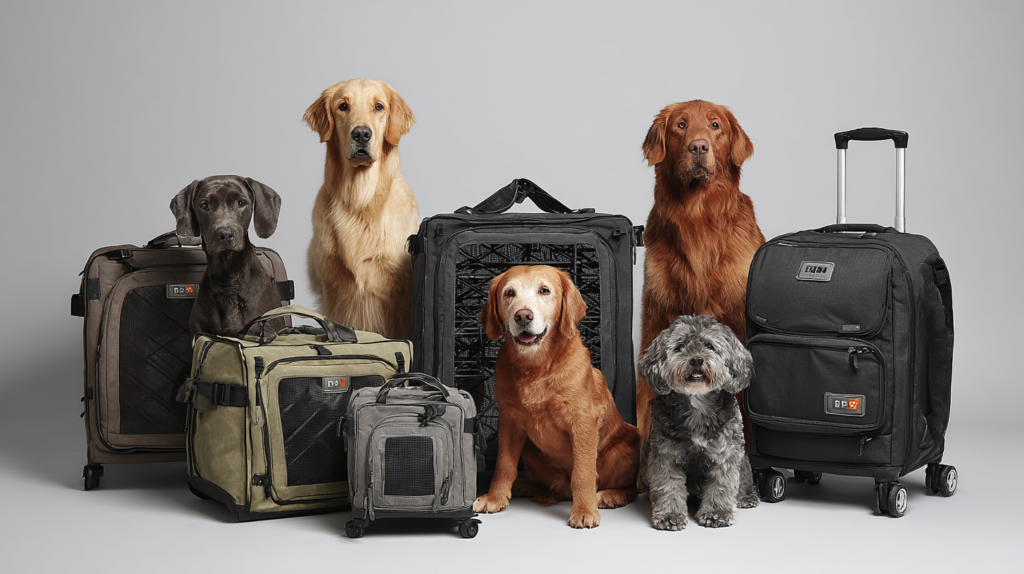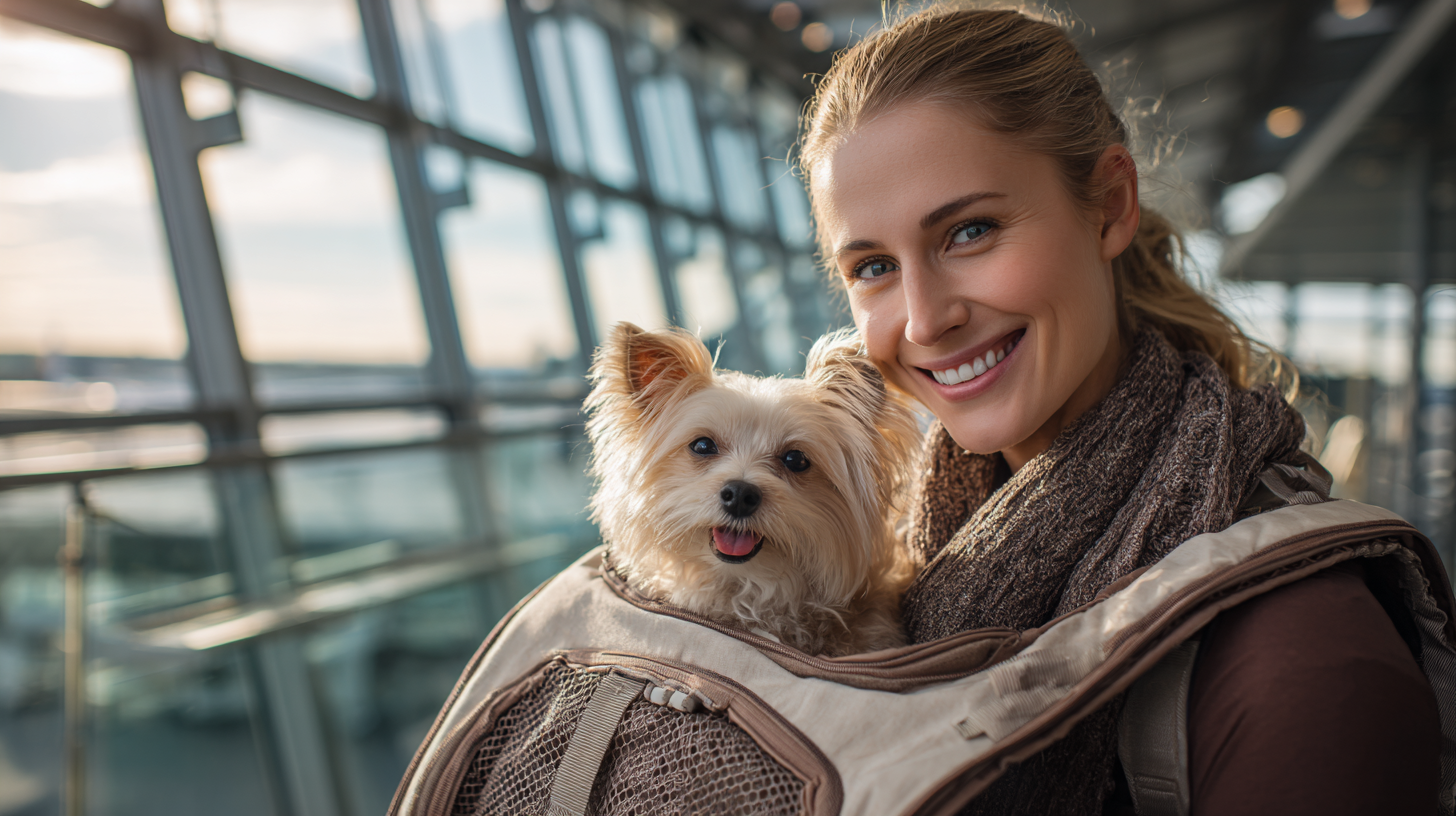Discover the best dog carriers for 2025! Expert guide covering airline-approved, soft, hard & wheeled carriers with safety tips for comfortable pet travel.
Table of Contents
Did you know that over 37% of pet owners now travel with their dogs regularly, yet nearly 60% struggle to find the right carrier for their furry companion? Whether you’re planning a cross-country flight, a weekend road trip, or simply need a secure way to transport your dog to the vet, choosing the right dog carrier is crucial for both safety and comfort.
A quality dog carrier serves as your pet’s mobile sanctuary, providing security, comfort, and peace of mind during travel. With countless options flooding the market in 2025, selecting the perfect carrier can feel overwhelming. From airline-approved hard cases to luxurious soft-sided carriers, each type offers unique benefits tailored to specific travel needs and dog personalities.
This comprehensive guide will walk you through everything you need to know about dog carriers, including expert recommendations, safety considerations, and practical tips from veterinary professionals. By the end of this article, you’ll have the knowledge to make an informed decision that ensures your beloved companion travels safely and comfortably, no matter the destination.
Understanding Different Types of Dog Carriers

Soft-Sided Dog Carriers: Maximum Comfort and Flexibility
Soft-sided carriers remain the most popular choice among pet owners, and for good reason. These versatile carriers offer superior comfort while maintaining portability and ease of use. Made from durable fabrics like nylon or canvas, they typically feature mesh panels for ventilation and visibility.
The primary advantage of soft-sided carriers lies in their flexibility. They can compress slightly to fit under airplane seats or squeeze into tight car spaces. Most models include padded straps for comfortable carrying, and many feature wheels for easy transport through airports or busy streets.
However, soft carriers aren’t suitable for every situation. They provide minimal protection during accidents and may not contain particularly determined escape artists. Dogs who tend to scratch or chew should use harder alternatives to prevent damage and potential escapes.
Hard-Sided Dog Carriers: Ultimate Protection and Security
Hard-sided carriers, typically constructed from high-impact plastic or lightweight aluminum, offer maximum protection for your pet. These carriers excel in situations requiring enhanced security, such as airline travel or transporting anxious dogs who might attempt to escape.
Airlines often prefer hard-sided carriers because they maintain their shape under pressure and provide better protection for pets in cargo holds. The rigid construction prevents collapse and ensures adequate ventilation even when other luggage is stacked nearby.
The main drawback of hard carriers is their bulk and weight. They’re less convenient for short trips and require more storage space. Additionally, they can feel more confining for dogs who prefer to see their surroundings clearly.
Wheeled Dog Carriers: Convenience Meets Functionality
Wheeled carriers combine the benefits of traditional carriers with the convenience of rolling luggage. These innovative designs feature sturdy wheels and extendable handles, making them ideal for longer distances or when carrying additional pet supplies.
Most wheeled carriers offer dual functionality – they can be rolled like luggage or carried traditionally when needed. This versatility makes them excellent for airport travel, where you might need to navigate stairs or escalators.
The additional mechanisms in wheeled carriers can sometimes fail, and they tend to be heavier than their non-wheeled counterparts. Regular maintenance of wheels and handles is essential to ensure long-term reliability.
Backpack Dog Carriers: Hands-Free Adventure Companions
Backpack carriers cater to active pet owners who enjoy hiking, biking, or urban exploration with their small dogs. These carriers distribute weight evenly across your shoulders and back, making them comfortable for extended wear.
Modern backpack carriers feature advanced ventilation systems, multiple entry points, and even hydration compatibility. Some models include detachable components that convert into traditional carriers or car seats.
Weight distribution becomes crucial with backpack carriers. They’re typically limited to smaller dogs (under 25 pounds) and require proper fitting to prevent back strain or discomfort during extended use.
Safety Considerations for Dog Carrier Selection
Size and Fit Guidelines
Proper sizing is arguably the most critical factor in carrier selection. A carrier that’s too small causes stress and discomfort, while one that’s too large can be dangerous during sudden stops or turbulence.
Your dog should be able to stand, turn around, and lie down comfortably inside the carrier. Measure your dog’s height from floor to top of head, length from nose to tail base, and width at the widest point. Add 2-3 inches to each measurement for comfort.
For airline travel, check specific airline requirements, as each carrier has different size restrictions. Some airlines measure carriers by external dimensions, while others focus on internal space.
Ventilation and Airflow Requirements
Adequate ventilation is non-negotiable for dog carriers. Poor airflow can lead to overheating, anxiety, and in extreme cases, heat stroke. Look for carriers with mesh panels on at least two sides, preferably three or four.
The mesh should be fine enough to prevent small paws from getting caught while allowing maximum airflow. Some carriers feature additional ventilation fans or cooling pads for extended travel in warm climates.
Never use carriers with inadequate ventilation, especially in warm weather or during air travel. The confined space can quickly become dangerous if proper airflow isn’t maintained.
Security Features and Escape Prevention
Dogs can be surprisingly resourceful when trying to escape confined spaces. Look for carriers with secure, multi-point locking systems that can’t be easily manipulated by clever paws.
Zippers should be high-quality and preferably lockable. Some carriers feature additional security clips or ties that prevent accidental opening. For particularly anxious or escape-prone dogs, consider carriers with reinforced seams and extra security features.
Test all locking mechanisms before travel, and consider practicing with your dog in the carrier before your actual trip. This helps identify potential security issues while you’re still at home.
Airline-Approved Dog Carriers: Flying with Your Pet
Understanding Airline Regulations
Each airline maintains specific requirements for pet carriers, and these regulations can change frequently. Most airlines require carriers to fit completely under the seat in front of you, which typically means maximum dimensions of 18″ x 11″ x 11″ for in-cabin travel.
Hard-sided carriers are usually required for cargo hold transport, while soft-sided carriers are acceptable for in-cabin travel. Some airlines have specific approved carrier lists, while others provide general guidelines.
Always check with your specific airline before purchasing a carrier. Requirements can vary significantly between domestic and international flights, and some destinations have additional restrictions or quarantine requirements.
TSA Security Considerations
The Transportation Security Administration (TSA) requires pet carriers to go through X-ray machines, which means your dog must be removed during security screening. This process can be stressful for both you and your pet.
Consider carriers with easy-access openings that allow quick removal without completely disassembling the carrier. Some travelers find that carriers with top openings are easier to manage during security checks.
Bring a slip-on harness or secure collar for security screening. Many dogs become anxious during this process, and a secure restraint prevents escape attempts in busy airport environments.
In-Flight Comfort Tips
Long flights can be challenging for dogs, even in comfortable carriers. Include familiar items like a favorite blanket or toy to provide comfort and reduce anxiety. Avoid feeding your dog heavily before travel, but ensure they’re well-hydrated.
Consider natural calming aids like pheromone sprays or anxiety wraps, but consult your veterinarian before using any supplements. Some dogs benefit from practice sessions in their carrier before travel day.
Position the carrier so your dog can see you during the flight. Your presence provides reassurance and helps reduce travel-related stress.
Selecting the Right Size Dog Carrier
Measuring Your Dog Correctly
Accurate measurements are essential for carrier selection. Use a flexible measuring tape and measure your dog while they’re standing in a natural position. Height should be measured from the floor to the top of their head or ears, whichever is taller.
Length measurements should extend from the tip of the nose to the base of the tail, not including the tail itself. Width should be measured at the widest point, typically across the shoulders or chest.
For growing puppies, consider their expected adult size when selecting a carrier. While you don’t want a carrier that’s too large for safe travel, you also don’t want to outgrow it quickly.
Weight Considerations
Weight limits vary significantly between carrier types and brands. Soft-sided carriers typically support less weight than hard-sided alternatives. Always check the manufacturer’s weight specifications and add a safety margin.
Consider not just your dog’s weight, but also any additional items like blankets, toys, or water bottles. These extras can add significant weight and affect the carrier’s balance and your comfort while carrying.
For larger dogs, wheeled carriers can help manage weight, but you’ll still need to lift the carrier at times. Ensure you can comfortably manage the total weight for safety reasons.
Comfort vs. Security Balance
Finding the right balance between comfort and security depends on your dog’s personality and travel requirements. Anxious dogs might prefer slightly smaller spaces that feel more secure, while confident dogs often appreciate more room to move.
Consider your dog’s sleeping preferences. Dogs who like to stretch out need more length, while those who prefer to curl up might be comfortable in more compact carriers.
Test different configurations with your dog before committing to a purchase. Some pet stores allow you to try carriers in-store, which can be invaluable for finding the right fit.
Top Features to Look for in Dog Carriers
Durability and Construction Quality
High-quality carriers should withstand regular use without showing significant wear. Look for reinforced seams, heavy-duty zippers, and quality hardware that won’t break under stress.
The base of the carrier should be sturdy enough to prevent sagging, which can be uncomfortable for your dog and make the carrier difficult to carry. Some carriers feature removable, washable liners that extend the product’s life.
Check warranty information and customer reviews for real-world durability feedback. A carrier that fails during travel can be dangerous and stressful for everyone involved.
Ease of Cleaning and Maintenance
Pet carriers require regular cleaning to maintain hygiene and prevent odors. Look for carriers with removable, machine-washable components whenever possible.
Hard-sided carriers are typically easier to clean and disinfect, while soft-sided carriers may require more care to prevent damage during washing. Some carriers feature antimicrobial treatments that help prevent odor and bacteria buildup.
Consider how easy it is to access all areas of the carrier for cleaning. Carriers with complex designs or hard-to-reach corners can harbor bacteria and odors over time.
Storage and Portability
When not in use, carriers should store efficiently without taking up excessive space. Many soft-sided carriers fold flat or collapse for easy storage.
Consider the weight and bulk of the carrier when empty. If you’ll be carrying it frequently, a lightweight design becomes more important than if it’s primarily used for car travel.
Some carriers feature additional storage compartments for treats, documentation, or small accessories. While convenient, these additions can add weight and complexity to the design.
Common Mistakes to Avoid When Buying Dog Carriers
Choosing Based on Price Alone
While budget considerations are important, the cheapest carrier isn’t always the best value. Low-quality carriers may fail when you need them most, potentially endangering your pet or causing travel disruptions.
Consider the total cost of ownership, including potential replacements, repairs, and any additional accessories needed. A higher-quality carrier that lasts for years may be more economical than repeatedly replacing cheaper alternatives.
However, the most expensive carrier isn’t necessarily the best either. Focus on features that matter for your specific needs rather than premium options you’ll never use.
Ignoring Your Dog’s Personality
Some dogs are naturally more anxious or claustrophobic than others. A carrier that works well for a calm, confident dog might cause significant stress for an anxious pet.
Consider your dog’s behavior in confined spaces. Dogs who become destructive when stressed need more durable carriers, while those who simply become anxious might benefit from carriers with better visibility.
If your dog has never been in a carrier, introduce them gradually before your travel date. This helps identify any issues and allows time for adjustment or alternative arrangements.
Overlooking Ventilation Requirements
Inadequate ventilation is one of the most dangerous carrier features to overlook. Dogs can overheat quickly in poorly ventilated spaces, especially during warm weather or stressful situations.
Don’t assume that a few small holes provide adequate airflow. Look for substantial mesh panels that allow for cross-ventilation. The mesh should be positioned to remain unobstructed even when the carrier is placed against seats or walls.
Consider the climate and conditions where you’ll be using the carrier. Extended car travel in warm weather requires better ventilation than short trips in cool conditions.
Expert Tips for Dog Carrier Training
Gradual Introduction Techniques
Never force your dog into a carrier for the first time on travel day. Start by leaving the carrier open in your home with the door removed or secured open. Allow your dog to explore and investigate at their own pace.
Place treats, toys, or meals inside the carrier to create positive associations. Many dogs naturally begin using the carrier as a comfortable resting spot once they become familiar with it.
Gradually increase the time your dog spends in the carrier, first with the door open, then closed for short periods. Always reward calm behavior and never use the carrier as punishment.
Making the Carrier Comfortable
Add familiar scents and textures to help your dog feel secure. A favorite blanket or piece of your clothing can provide comfort during stressful travel situations.
Consider the temperature inside the carrier. In cold weather, additional blankets might be helpful, while warm weather might require cooling mats or fans.
Some dogs prefer carriers with solid sides that provide more privacy, while others want maximum visibility. Observe your dog’s preferences and adjust accordingly.
Practice Sessions Before Travel
Conduct practice sessions that simulate actual travel conditions. This might include carrying the carrier around the house, placing it in the car, or even taking short drives.
For air travel, practice the security screening process at home. Get your dog comfortable with being removed from the carrier quickly and calmly.
Time your practice sessions to coincide with your planned travel schedule. If you’ll be traveling early in the morning, practice during those hours to help your dog adjust.
Maintenance and Care for Dog Carriers
Regular Cleaning Protocols
Establish a regular cleaning routine to maintain hygiene and prevent odors. Even if the carrier doesn’t appear dirty, regular cleaning prevents bacteria buildup and extends the product’s life.
For soft-sided carriers, check manufacturer instructions for machine washing. Some components may require hand washing or air drying to prevent damage.
Hard-sided carriers can typically be cleaned with pet-safe disinfectants. Pay special attention to corners and crevices where debris might accumulate.
Inspection and Repair Guidelines
Regularly inspect your carrier for signs of wear or damage. Check zippers, seams, handles, and any moving parts for proper function.
Small issues like loose threads or minor zipper problems can often be repaired before they become major failures. Address these issues promptly to prevent more extensive damage.
Keep replacement parts when available. Some manufacturers offer replacement zippers, handles, or other components that can extend the carrier’s useful life.
Storage Best Practices
Store carriers in clean, dry locations away from direct sunlight and extreme temperatures. UV exposure can weaken fabrics and plastics over time.
If storing for extended periods, ensure the carrier is completely clean and dry to prevent mold or mildew growth. Consider using moisture absorbers in humid storage areas.
Store carriers in a way that prevents crushing or deformation. Some carriers come with storage bags or cases that help maintain their shape during storage.
When to Consult a Veterinarian
Travel Stress and Anxiety Signs
Some dogs experience significant stress during travel, regardless of carrier quality. Signs include excessive panting, drooling, trembling, or attempts to escape.
If your dog shows severe anxiety symptoms, consult your veterinarian before travel. They may recommend behavioral training, anxiety medications, or alternative travel arrangements.
Never ignore signs of distress, as prolonged stress can lead to serious health issues. Some dogs may require professional behavioral training to overcome travel anxiety.
Health Considerations for Travel
Certain health conditions can make travel dangerous or uncomfortable for dogs. Heart conditions, respiratory issues, or mobility problems may require special considerations or veterinary clearance.
Discuss your travel plans with your veterinarian, especially for long trips or air travel. They can provide health certificates required for travel and advice on managing your dog’s specific needs.
Some medications can help with travel anxiety or motion sickness, but these should only be used under veterinary guidance.
Emergency Preparedness
Know the signs of heat stroke, which can occur quickly in confined spaces. Symptoms include excessive panting, difficulty breathing, and lethargy.
Keep your veterinarian’s contact information readily available during travel, along with information about emergency veterinary services at your destination.
Consider pet insurance that covers travel-related emergencies. Some policies include coverage for trip cancellations due to pet health issues.
Educational Table:
Markdown Version:
| Carrier Type | Best For | Weight Limit | Price Range | Key Features |
|---|---|---|---|---|
| Soft-Sided | Short trips, in-cabin flights | 15-25 lbs | $30-$150 | Flexible, comfortable, multiple entry points |
| Hard-Sided | Airline cargo, anxious dogs | 25-70 lbs | $50-$300 | Maximum protection, secure, durable |
| Wheeled | Airport travel, heavy dogs | 20-40 lbs | $80-$250 | Rolling convenience, dual functionality |
| Backpack | Hiking, hands-free carry | 8-20 lbs | $40-$180 | Weight distribution, adventure-ready |
| Convertible | Multi-purpose use | 15-30 lbs | $60-$220 | Versatile, space-saving, multiple configurations |
FAQ Section:
Q: What size dog carrier do I need for airline travel?
A: Measure your dog’s height, length, and width, then add 2-3 inches to each dimension. Most airlines require carriers to fit under the seat, typically 18″ x 11″ x 11″ maximum. Always check your specific airline’s requirements before purchasing.
Q: Are soft-sided or hard-sided dog carriers better?
A: Soft-sided carriers offer more flexibility and comfort for in-cabin travel, while hard-sided carriers provide maximum protection and security. Choose based on your travel method and your dog’s needs.
Q: How do I get my dog comfortable in a carrier?
A: Start by leaving the carrier open at home with treats and toys inside. Gradually increase the time your dog spends in the carrier, always rewarding calm behavior. Practice sessions before travel help reduce anxiety.
Q: Can I use a dog carrier for a puppy?
A: Yes, but consider the puppy’s expected adult size. You may need to upgrade as they grow. Ensure the carrier isn’t too large for safe travel, as puppies can be injured in oversized carriers during sudden stops.
Q: What features should I look for in a dog carrier?
A: Essential features include proper ventilation, secure locking mechanisms, durable construction, easy cleaning, and comfortable carrying options. Size appropriateness and your dog’s specific needs are most important.
Q: How often should I clean my dog carrier?
A: Clean after every use, or at least monthly for regular users. Regular cleaning prevents odors and bacteria buildup. Check manufacturer instructions for specific cleaning requirements.
Q: Are wheeled dog carriers worth the extra cost?
A: Wheeled carriers are valuable for airport travel and heavier dogs, but they’re bulkier and may require more maintenance. Consider your typical travel scenarios and physical capabilities when deciding.
Conclusion
Selecting the right dog carrier is an investment in your pet’s comfort, safety, and your peace of mind during travel. From soft-sided carriers that offer flexibility and comfort to hard-sided options that provide maximum protection, each type serves specific needs and situations.
Remember that the best carrier for your dog depends on their size, personality, and your travel requirements. Take time to properly measure your pet, consider their comfort preferences, and practice using the carrier before your actual travel date.
Quality carriers with proper ventilation, security features, and durable construction will serve you well for years to come. While initial costs might seem significant, investing in a well-made carrier ensures safe, comfortable travel experiences for both you and your beloved companion.
Whether you’re planning a cross-country adventure or simply need reliable transportation for veterinary visits, the right carrier makes all the difference. Your dog’s safety and comfort should always be the top priority when making your selection.
For more expert pet care tips and product recommendations, visit BlithePet.com your trusted source for pet wellness.
Have a similar experience with your pet? Share it in the comments below! Don’t forget to check out our other helpful guides at BlithePet.com.







